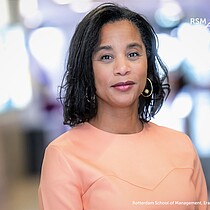

Article: Thursday, 9 November 2023
Major changes in the market for display advertising – online ads in the form of images, videos, or GIFs – in recent years might not have the beneficial effects that advertisers and publishers hoped for. The changes came in the form of programmatic advertising, a high-tech real-time supply chain that facilitates the transaction and delivery of ad impressions. However, there’s still a generalised lack of transparency here because of its complex competitive and technological landscape. A deep investigation reveals the conflicting incentives that it contains.
Francesco Balocco, PhD candidate in the Department of Technology and Operations Management at Rotterdam School of Management, Erasmus University (RSM) made three studies that investigated the role of asymmetric information in the relationships between advertisers (buyers), publishers (sellers), and ad exchanges (auction platforms) in the programmatic supply chain for online advertisements.
Department of Technology and Operations Management at RSM

Growing up in Italy in the 1990s meant witnessing the golden age of Italian commercial television, where everything was colourful, amazing, and, most importantly, for sale! I also love asymmetric information as an economic concept. I love the idea of reverse-engineering and exposing the ways in which market operators take advantage of each other. I decided to take this passion into my PhD trajectory. During my first year of doctorate studies, I went to a conference and got talking to people – that’s when I discovered auctions. I got extremely interested in them and decided that I had to learn more, so I combined the three things into my thesis.
Balocco’s three studies provide new insight into the digital advertising market by highlighting the effects of asymmetric information, conflicting incentives, and mechanism choices in programmatic advertising. In short, he found:
Private marketplace (PMP) contracts do not benefit advertisers and damage the competition.
Some Publishers may tolerate price manipulation in second-price auctions when service fees in first-price auctions are higher.
Contrarily to common understanding, HeaderBidding's lack of upstream competition allows ADXs to increase supply-side fees, potentially reducing publisher revenues.
His results could be interesting for advertising practitioners, competition authorities, European commission, and market regulation authorities. Balocco successfully defended his dissertation, Asymmetric Information in Programmatic Advertising. Three studies on adverse selection, mechanism choices, and fee structures on Friday 8 September.
The first study examines the coexistence of open real-time bidding auction markets (RTB) and private marketplaces (PMP). Balocco found that allocating ad impressions to private marketplaces through premium contracts does not benefit advertisers, and actually leads to adverse selection in real-time bidding.
So while the digital advertising market praises the use of private marketplaces as a move towards more transparent markets, they actually generate perverse incentives for sellers, who benefit from damaging competitors by selectively allocating their inventory between RTB and PMP. “Previous literature does not report this effect because they do not consider that advertising markets are supply-constrained (i.e., you only have a finite amount of ad spaces to show) and therefore does not capture that PMPs lead to adverse selection.
This happens in a market of more than US$ 500 billion, and more than half of the market is affected by this practice.”

The second study focuses on ad exchanges, the online places where advertisers and publishers can buy and sell ad inventory directly through real-time bidding without the need for an intermediary. ADXs do not give a choice, but rather adopt one of the two mechanisms: some use the first-price and some use the second-price auction. In second-price auctions, advertisers bid on available ad inventory, and the advertiser with the highest bid wins the auction but instead of paying their bid amount, they pay the second-highest bid amount. Balocco’s results suggest that despite widespread mistrust in their commitment to auction rules, ad exchanges offering second-price auctions can gain a relevant market share depending on their competitors' fee policies. The core issue is that in second-price auctions, auctioneers can manipulate the price, while in first-price auction they cannot.
He is able to explain why: previous research leads us to expect second-price auctions to disappear from the market,
but in digital advertising they have dominated the landscape for a long time. Sometimes, allowing ad exchanges to run second-price auctions may have been more convenient for publishers than paying higher fees to more transparent ad exchanges that offered first-price auctions. “What we find in our paper is that sometimes for publishers it’s more convenient to allow for price manipulation by ad exchanges than paying for fees.”
But in contrast to previous research, Balocco considered intermediary auctioneers that compete for market shares by setting fees and selecting their mechanism, and thereby capture the sellers’ trade-off between fees and transparency.
He comments: “This is interesting because it settles the debate on the ad exchanges’ move to the first-price auction that still remains open in the literature. Moreover it gives a novel explanation as to why second-price auctions are still common in digital auctions despite their drawbacks.”

The third study examines the impact of publishers' mechanism changes on ad exchanges' incentives to set buy-side and sell-side fees. Balocco shows that the incentive for Ad Exchanges to maintain lower sell-side fees, ultimately improving publishers' revenues, has been eliminated by a shift in the way bidding is done. When sell-side fees are low, seller’s revenues are high. Previously, the waterfall mechanism had been used; the ad request cascades from one ad source to the next until it reaches an ad network willing to fill the request. The shift to header bidding that allows publishers to offer their ad inventory to multiple ad exchanges and ad networks simultaneously had eliminated lower sell-side fees.
He shows that when publishers migrate to header bidding, ad exchanges lose any incentive to keep sell-side fees under control, and end up eating away all publishers’ profits.
“This is interesting because while literature and industry practitioners see header bidding as a revenue-improving move for publishers, publishers are struggling to keep their ad revenues consistent due to an unprecedented surge in sell-side fees.”
Overall, Balocco’s studies provide new insight into the digital advertising market by highlighting the effects of asymmetric information, conflicting incentives, and mechanism choices in programmatic advertising.
Francesco Balocco’s PhD promoter and co-promoter were Prof. Ting Li and Prof. Eric Van Heck from RSM, and the doctoral committee members were: Prof. Gaia Rubera (Bocconi University), Dr Yashar Ghiassi-Farrokhfal (RSM), Dr Jason Roos (RSM), Prof. Alok Gupta (University of Minnesota), and Dr Yixin Lu (The George Washington University).
Read Francesco Balocco’s dissertation, Asymmetric Information in Programmatic Advertising. Three studies on adverse selection, mechanism choices, and fee structures here:


Science Communication and Media Officer

Corporate Communications & PR Manager
Rotterdam School of Management, Erasmus University (RSM) is one of Europe’s top-ranked business schools. RSM provides ground-breaking research and education furthering excellence in all aspects of management and is based in the international port city of Rotterdam – a vital nexus of business, logistics and trade. RSM’s primary focus is on developing business leaders with international careers who can become a force for positive change by carrying their innovative mindset into a sustainable future. Our first-class range of bachelor, master, MBA, PhD and executive programmes encourage them to become to become critical, creative, caring and collaborative thinkers and doers.
